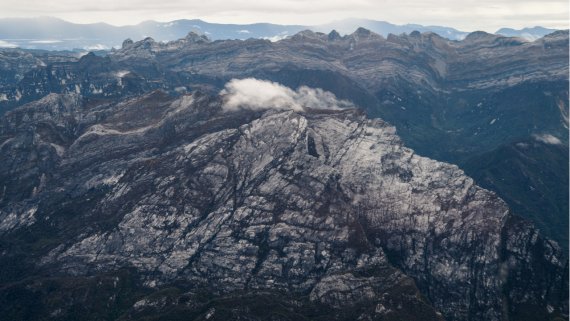
It sounds strange in this day and age, but there are no exact topographic maps for the mountain regions of New Guinea. Yet it is precisely here that some of the mightiest peaks on our planet rise. Since the island belongs to Oceania from a geographical point of view, the question of the exact height of the mountains has become increasingly interesting for alpinists. After all, on the Australian mainland the highest elevations are barely half as high - the highest mountain is Mount Kosciuszko at 2,228 meters - and so the Oceania candidates for the famous "Seven Summits" and "Seven Second Summits" are on New Guinea. So at least for the Summits model of the South Tyrolean mountaineer Reinhold Messner this is true, and many alpinists follow him in this view.
It is largely undisputed that the Carstensz Pyramid is the highest peak in Oceania, at 4,884 metres. But after that it gets tight: Ngga Pulu, Puncak Mandala, Puncak Trikora, Ngga Pilimsit or Sumantri? Ngga Pulu, secondary peak of the Carstensz pyramid, was even higher than today's No.1 before the progressive melting of the ice cap. That has changed. At the same time, there is increasing doubt as to whether it is even a mountain in its own right.
Summits hunter Hans Kammerlander from South Tyrol initially favoured Puncak Trikora, while competitor Christoph Stangl from Austria still saw all the criteria fulfilled on Ngga Pulu. There were also strong votes for the Puncak Mandala and the Ngga Pilimsit. And finally there was the Sumantri, in 2012 by the US mountaineering website peakbagger.com well justified at the top of the Second Summits.
The unclear situation, which is favoured by the changes in altitude caused by melting glaciers, meant that mountaineers like Stangl had to climb various peaks in order to have safely mastered all the "Seven Second Summits", i.e. the second highest peaks on each of the seven continents. At the same time, however, the Austrian used this opportunity to take his own measurements during his ascents. In the process, the height of Sumantri was also confirmed by him. At the same time Stangl attested him the corresponding prominence. This describes (besides dominance) the independence of a peak in comparison to its surroundings. Since Sumantri is separated from the neighbouring Carstensz pyramid by a valley, this prominence is about 350 metres. Conjectures that it could be a mere secondary peak were thus shattered.
Sumantri is climbed from the south and is considered technically easy. Attempts to reach the summit via the rugged north face are not known. However, the general prerequisite for the summit attempt is that the political situation in Indonesia allows it and that appropriate permits are granted. This was not always guaranteed. From the mid-1990s, access was even completely blocked and only reopened about a decade later.
The first first ascent of Sumantri is credited to Austrian Heinrich Harrer and Briton Philip Temple, who tackled several mountains in the region - including Carstensz Pyramid - in 1962. Temple later put his experiences on paper in the book Snow Over the Rainforest - With Heinrich Harrer on the Peaks of New Guinea. Harrer's various book publications also contain details of this.
Whether the two men were actually the first people to stand on Sumantri is, however, an open question. The region had been explored several times before, including in 1936 by a group of Dutch mountaineers who demonstrably climbed Ngga Pulu. However, the expedition to Sumantri was not documented at the time.
 OutDoor by ISPOOutDoor in transition
OutDoor by ISPOOutDoor in transition
- ISPO awards
- Mountain sports
- Bike
- Design
- Retail
- Fitness
- Health
- ISPO Job Market
- ISPO Munich
- ISPO Shanghai
- Running
- Brands
- Sustainability
- Olympia
- OutDoor
- Promotion
- Sports Business
- ISPO Textrends
- Triathlon
- Water sports
- Winter sports
- eSports
- SportsTech
- OutDoor by ISPO
- Heroes
- Transformation
- Sport Fashion
- Urban Culture
- Challenges of a CEO
- Trade fairs
- Sports
- Find the Balance
- Product reviews
- Newsletter Exclusive Area
- Magazine




